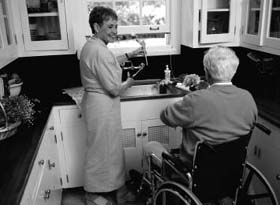By CYN LoPINTO
Editor-in-chief, gerontologist
 Household accidents can cause an unexpected visit to your local emergency room. Avoid the trip. Take a look around your kitchen, bedrooms, bathrooms and living area to see if the following simple suggestions could help you or those you love remain safe.
Household accidents can cause an unexpected visit to your local emergency room. Avoid the trip. Take a look around your kitchen, bedrooms, bathrooms and living area to see if the following simple suggestions could help you or those you love remain safe.
Kitchen
- Keep paper towels, napkins and potholders away from burners
- Make sure kitchen floor is free of clutter
- Avoid loose-fit clothing while cooking (roll up or fasten long sleeves)
- Store knives so blades are protected
- Do not leave cooking pots unattended
- Check oven and stove dials to see if they are easy to read (on older appliances the marking may be scratched off), replace if necessary
- Have adequate lighting in all areas
- Fasten all kitchen floor mats with adhesive strips or replace with the non-skid types (check these periodically)
- Label hot/cold faucets and make sure water temperature does not exceed 120 degrees or scalding can occur
- Use exhaust fan (hood) over stove or oven while cooking
- Place a multipurpose (A,B and C type) fire extinguisher in easy reach
Bathroom
- Secure toilet seat to toilet and if using raised seat or safety frame, make sure it is installed properly
- Have a non-skid bath mat or tub strips fastened to the tub surface
- Purchase a bath seat or transfer bench for safer movement in and out of tub
- Keep electrical equipment (hair dryers, electric shavers, etc.) away from water
- Place a night light in the bathroom for evening use
- Install grab bars properly to bathroom wall beams (towel racks should NEVER be substituted for grab bars and are a leading cause of many household accidents)
- Lay a large piece of carpet in the bathroom area instead of the traditional bath-size rugs
- Label hot/cold faucets clearly and make sure water temperature does not exceed 120 degrees
Bedroom
- Do not tuck blankets tightly in case you need to get out of your bed in a hurry (especially true for electric blankets which may get too hot)
- Keep a bedroom night light on or install a light switch near the bed for those late night bathroom trips
- Have a telephone next to the bed for emergencies
- Avoid smoking in bed (if you must, make sure ashtray is well away from all bedding)
- Place all mobility equipment (canes, walkers, wheelchairs, etc.) close by the bed for fast access
Living Area
- Make sure all telephone and electrical wires are out of walkways
- Replace standard door knobs with lever-type handles for those with limited grip
- Secure stairways by placing light switches at both the top and bottom of flight and install full length railing on both sides
- Provide a well-lit area throughout the entire house (use non-glare or frosted bulbs)
- Remove or properly fasten area rugs to floor (if wall-to-wall carpeting is throughout the home, check for bubbling, fraying or high spots that could cause accidents)
- Ensure furniture is sturdy (especially if used for support while getting up and down)
- Arrange coffee and end tables so they are out of the way of walking areas
The following two tabs change content below.


Cynthia Lopinto
Cyn LoPinto, M.A. is a gerontologist focusing on significant issues affecting older adults and their families. Her areas of interest include lifestyle enrichment, family dynamics, and caregiver support. Cyn has worked in both the recreational and healthcare industries.
Latest posts by Cynthia Lopinto (see all)
- Honey Chocolate–Covered Pretzels - April 3, 2018
- True Colors - April 3, 2018
- Spring Cleaning…You’ve Gotta Be Kidding - April 2, 2018
- Should You Stay In Your Home Or Move During Retirement? - April 2, 2018
- Hawaiian Plants For Good Health - April 2, 2018
 Home Front Magazine A Publication for Seniors
Home Front Magazine A Publication for Seniors

